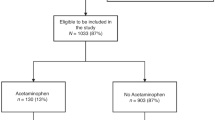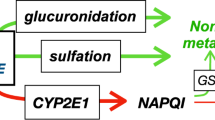Abstract
Background
Exposure to acetaminophen and its metabolites in very-preterm infants is partly unknown. We investigated the exposure to acetaminophen and its metabolites upon 10, 15, or 20 mg/kg intravenous acetaminophen in preterm infants.
Methods
In a randomized trial, 59 preterm infants (24–32 weeks’ gestational age, postnatal age <1 week) received 10, 15, or 20 mg/kg acetaminophen intravenously. Plasma concentrations of acetaminophen and its metabolites (glucuronide, sulfate, cysteine, mercapturate, and glutathione) were determined in 293 blood samples. Area under the plasma concentration–time curves (AUC0–500 min) was related to dose and gestational age.
Results
Between 10 and 20 mg/kg dose, median AUCs of acetaminophen, glucuronide, sulfate, and cysteine increased significantly resulting in unchanged ratios of AUC of metabolite to acetaminophen. The AUC ratio of glucuronide to acetaminophen increased with gestational age, that of sulfate decreased, and the ratio of cysteine and mercapturate remained unchanged.
Conclusion
We found a gestational-age-dependent increase in glucuronidation but no evidence for saturation of a specific pathway as there was a proportional increase in exposure of acetaminophen and all metabolites. Compared with adults, very low exposure to glucuronide but higher exposure to sulfate, cysteine, and mercapturate metabolites was found, of which the relevance is not yet known.
Similar content being viewed by others
Log in or create a free account to read this content
Gain free access to this article, as well as selected content from this journal and more on nature.com
or
References
Roofthooft DW, Simons SH, Anand KJ et al, Eight years later are we still hurting newborn infants? Neonatology 2014;105:218–26.
Carbajal R, Rousset A, Danan C et al, Epidemiology and treatment of painful procedures in neonates in intensive care units. JAMA 2008;300:60–70.
Menon G, McIntosh N. How should we manage pain in ventilated neonates? Neonatology 2008;93:316–23.
Carbajal R, Eriksson M, Courtois E et al, Sedation and analgesia practices in neonatal intensive care units (EUROPAIN): results from a prospective cohort study. Lancet Respir Med 2015;3:796–812.
Autret E, Dutertre JP, Breteau M et al, Pharmacokinetics of paracetamol in the neonate and infant after administration of propacetamol chlorhydrate. Dev Pharmacol Ther 1993;20:129–34.
Allegaert K, Anderson BJ, Naulaers G et al, Intravenous paracetamol (propacetamol) pharmacokinetics in term and preterm neonates. Eur J Clin Pharmacol 2004;60:191–7.
Prescott LF. Kinetics and metabolism of paracetamol and phenacetin. Br J Clin Pharmacol 1980;10 (Suppl 2):291S–8SS.
Kim DW, Tan EY, Jin Y et al, Effects of imatinib mesylate on the pharmacokinetics of paracetamol (acetaminophen) in Korean patients with chronic myelogenous leukaemia. Br J Clin Pharmacol 2011;71:199–206.
Arana A, Morton NS, Hansen TG. Treatment with paracetamol in infants. Acta Anaesthesiol Scand 2001;45:20–9.
Rumack BH. Acetaminophen hepatotoxicity: the first 35 years. J Toxicol Clin Toxicol 2002;40:3–20.
Park JM, Lin YS, Calamia JC et al, Transiently altered acetaminophen metabolism after liver transplantation. Clin Pharmacol Ther 2003;73:545–53.
Manyike PT, Kharasch ED, Kalhorn TF et al, Contribution of CYP2E1 and CYP3A to acetaminophen reactive metabolite formation. Clin Pharmacol Ther 2000;67:275–82.
Chun LJ, Tong MJ, Busuttil RW et al, Acetaminophen hepatotoxicity and acute liver failure. J Clin Gastroenterol 2009;43:342–9.
Clements JA, Critchley JA, Prescott LF . The role of sulphate conjugation in the metabolism and disposition of oral and intravenous paracetamol in man. Br J Clin Pharmacol 1984;18:481–5.
Critchley JA, Nimmo GR, Gregson CA et al, Inter-subject and ethnic differences in paracetamol metabolism. Br J Clin Pharmacol 1986;22:649–57.
Forrest JA, Clements JA, Prescott LF. Clinical pharmacokinetics of paracetamol. Clin Pharmacokinet 1982;7:93–107.
Hinson JA, Roberts DW, James LP. Mechanisms of acetaminophen-induced liver necrosis. Handb Exp Pharmacol 2010: 369–405.
Jaeschke H, McGill MR, Ramachandran A. Oxidant stress, mitochondria, and cell death mechanisms in drug-induced liver injury: lessons learned from acetaminophen hepatotoxicity. Drug Metab Rev 2012;44:88–106.
Larson AM, Polson J, Fontana RJ et al, Acetaminophen-induced acute liver failure: results of a United States multicenter, prospective study. Hepatology 2005;42:1364–72.
Cook SF, Roberts JK, Samiee-Zafarghandy S et al, Population Pharmacokinetics of intravenous paracetamol (acetaminophen) in preterm and term neonates: model development and external evaluation. Clin Pharmacokinet 2016;55:107–19.
Cook SF, Stockmann C, Samiee-Zafarghandy S et al, Neonatal maturation of paracetamol (acetaminophen) glucuronidation, sulfation, and oxidation based on a parent-metabolite population pharmacokinetic model. Clin Pharmacokinet 2016;55:1395–411.
Wang C, Allegaert K, Tibboel D et al, Population pharmacokinetics of paracetamol across the human age-range from (pre)term neonates, infants, children to adults. J Clin Pharmacol 2014;54:619–29.
McGill MR, Jaeschke H. Metabolism and disposition of acetaminophen: recent advances in relation to hepatotoxicity and diagnosis. Pharm Res 2013;30:2174–87.
Hines RN. The ontogeny of drug metabolism enzymes and implications for adverse drug events. Pharmacol Ther 2008;118:250–267.
Allegaert K, de Hoon J, Verbesselt R et al, Intra- and interindividual variability of glucuronidation of paracetamol during repeated administration of propacetamol in neonates. Acta Paediatr 2005;94:1273–9.
Knibbe CA, Krekels EH, van den Anker JN et al, Morphine glucuronidation in preterm neonates, infants and children younger than 3 years. Clin Pharmacokinet 2009;48:371–85.
Cook SF, King AD, van den Anker JN et al, Simultaneous quantification of acetaminophen and five acetaminophen metabolites in human plasma and urine by high-performance liquid chromatography-electrospray ionization-tandem mass spectrometry: method validation and application to a neonatal pharmacokinetic study. J Chromatogr B Analyt Technol Biomed Life Sci 2015;1007:30–42.
van Lingen RA, Deinum JT, Quak JM et al, Pharmacokinetics and metabolism of rectally administered paracetamol in preterm neonates. Arch Dis Child Fetal Neonatal Ed 1999;80:F59–63.
Krekels EH, Danhof M, Tibboel D et al, Ontogeny of hepatic glucuronidation; methods and results. Curr Drug Metab 2012;13:728–43.
Krekels EH, van Ham S, Allegaert K et al, Developmental changes rather than repeated administration drive paracetamol glucuronidation in neonates and infants. Eur J Clin Pharmacol 2015;71:1075–82.
van Rongen A, Valitalo PA, Peeters MY et al, Morbidly obese patients exhibit increased CYP2E1-mediated oxidation of acetaminophen. Clin Pharmacokinet 2016;55:833–847.
Allegaert K, Rayyan M, De Rijdt T et al, Hepatic tolerance of repeated intravenous paracetamol administration in neonates. Paediatr Anaesth 2008;18:388–92.
van Ganzewinkel C, Derijks L, Anand KJ et al, Multiple intravenous doses of paracetamol result in a predictable pharmacokinetic profile in very preterm infants. Acta Paediatr 2014;103:612–7.
Allegaert K, Palmer GM, Anderson BJ. The pharmacokinetics of intravenous paracetamol in neonates: size matters most. Arch Dis Child 2011;96:575–80.
Roofthooft DW, van Beynum IM, de Klerk JC et al, Limited effects of intravenous paracetamol on patent ductus arteriosus in very low birth weight infants with contraindications for ibuprofen or after ibuprofen failure. Eur J Pediatr 2015;174:1433–40.
Allegaert K, Anderson B, Simons S et al, Paracetamol to induce ductus arteriosus closure: is it valid? Arch Dis Child 2013;98:462–6.
Hammerman C, Bin-Nun A, Markovitch E et al, Ductal closure with paracetamol: a surprising new approach to patent ductus arteriosus treatment. Pediatrics 2011;128:e1618–21.
Terrin G, Conte F, Oncel MY et al, Paracetamol for the treatment of patent ductus arteriosus in preterm neonates: a systematic review and meta-analysis. Arch Dis Child Fetal Neonatal Ed 2016;101:F127–36.
Author information
Authors and Affiliations
Corresponding author
Ethics declarations
Competing interests
The authors declare no conflict of interest.
Additional information
Statement of Financial Support
This study was enabled by funding from the Netherlands Organisation for Health Research and Development ZonMw (Grant number: 80-83600-98-10190).
Rights and permissions
About this article
Cite this article
Flint, R., Roofthooft, D., van Rongen, A. et al. Exposure to acetaminophen and all its metabolites upon 10, 15, and 20 mg/kg intravenous acetaminophen in very-preterm infants. Pediatr Res 82, 678–684 (2017). https://doi.org/10.1038/pr.2017.129
Received:
Accepted:
Published:
Issue date:
DOI: https://doi.org/10.1038/pr.2017.129
This article is cited by
-
Response of the ductus arteriosus to acetaminophen or indomethacin in extremely low birth weight infants
Journal of Perinatology (2025)
-
Paracetamol, its metabolites, and their transfer between maternal circulation and fetal brain in mono- and combination therapies
Pharmacological Reports (2025)
-
Postnatal acetaminophen exposure and neurodevelopmental outcomes at 18–21 months corrected gestational age in preterm infants <29 weeks gestation: a retrospective cohort study
Pediatric Research (2024)
-
Is postnatal acetaminophen therapy problematic for preterm infants?
Pediatric Research (2024)
-
Adverse Event Profile of First-line Drugs for Treating Patent Ductus Arteriosus in Neonates: A Disproportionality Analysis Study of USFDA Adverse Event Reporting System
Pediatric Drugs (2024)



